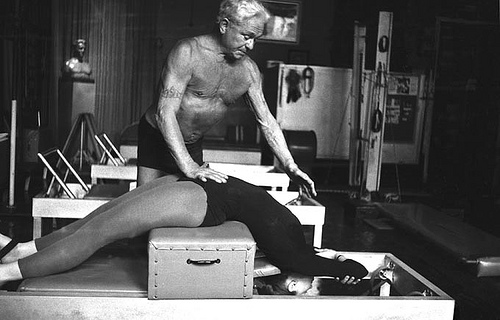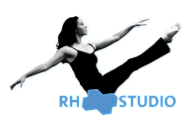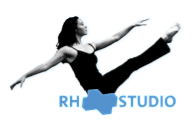RH+STUDIO | Pilates : Change Your Body For Good.
What is Pilates :
HISTORY
The basic historical facts about what is Pilates:
Who was Joseph Pilates?
When did he create his exercise method?
Who were his students?
Where was his studio?
What were his beliefs?
Joseph Hubertus PILATES who created the “Art of Contrology” or the “Pilates Method” of exercise as we all know it today. Pilates was born in Germany in 1880. He grew up just outside Dusseldorf and was rather sickly as a child, suffering from rickets, asthma and rheumatic fever. Determined to overcome his body weaknesses, Pilates worked on strengthening his body from the inside out through studying different forms of exercise such as martial arts, gymnastics, yoga and boxing. His ‘obsession’ for the human body and movement continued and he eventually developed his exercise method combining Eastern & Western philosophies of exercise.

The “Art of Contrology” (Pilates) emphasised the importance of muscle control and in particular, “using the mind to master the muscles”.
Interned because of his nationality at the outbreak of World War 1, he was placed in a work camp in England. Pilates developed quite a following during the war and despite the harsh living conditions and an influenza outbreak, Pilates and his followers not only survived but thrived from his innovative approach to health and fitness.
He worked with hospital patients who were bedridden and used bedsprings to apply movements and resistance to their muscles. Through this form of training, he found that his patients not only recovered quickly but became much stronger than ever before. It was the utilization of the springs & hospital beds that was a precursor to the Pilates modern-day equipment.
In the 1920′s Pilates emigrated to the United States. It was on his journey to the States that he met his future wife Clara, a nurse who shared his passion for developing and maintaining a strong and healthy body.
When in the US the couple opened a fitness studio in New York City. In the beginning, it was mainly elite artists such as dancers, choreographers and actors who embraced his method. Martha Graham and George Balanchine were devotees of the “Art of Contrology”.
Often injured dancers would go to pilates’ studio for rehabilitation and as a result became hooked on his exercise method, discovering that it provided the perfect complement to their dance training. Pilates’ exercise system creates musculoskeletal balance, correct breathing and spinal alignment. The exercises develop control of the body’s core muscles, ease of movement and mental focus.
Joseph Pilates believed that it is the mind itself which shapes the body and true focus restores the body to its natural balance.
Over the years, Pilates has become extremely popular within the fitness industry and is also used by many physiotherapists as part of their treatment program.
Through either or both resistance training on the Pilates equipment and Pilates Mat work you will notice that “in 10 sessions you will feel the difference, in 20 sessions, you will see the difference, and in 30 sessions, you will have a whole new body” (quote from Joseph, based on 3 sessions a week)
Pilates Principles:
Breathing
Alignment
Centring
Flow
Concentration
Precision
Alignment
Correct postural alignment of the body is crucial in Pilates, not only to get the best out of the exercise but also to prevent injury. Achieving optimal alignment starts with aligning the pelvis, ribcage, shoulder girdle, and head in a neutral position, and then recruiting the body’s stabilization muscles to maintain that alignment while performing the exercises.
Breathing
Pilates believed in improving blood circulation to awaken all the body’s cells and carry away waste products related to fatigue. For the blood to do function properly, he maintained, it has to be supplied with oxygen and rid of waste gases through correct breathing. Full and thorough inhalation and exhalation are a key part of every Pilates exercise.
Pilates breathing should be performed with control, concentration and precision. Correct breathing, not only oxygenates the muscles but also prevents and alleviates tension in the upper neck and shoulders. The “Pilates Way” of breathing is described as posterior lateral breathing, meaning that one breathes deep into the back and sides of the rib cage. When exhaling, the deep abdominal and pelvic floor muscles are gently engaged and then stay active during inhalation. The Pilates way of breathing is then coordinated with the Pilates exercises.
Centring
In Pilates, all movements are controlled from the body’s centre or as Joseph Pilates called it, the body’s powerhouse. By this, he meant the muscles that encompass the abdomen, lower back, hips and buttocks.
The Pilates the movements must be powered from the body’s centre sending energy flowing out to the limbs. In other words, physical energy exerted from the body’s ‘powerhouse’ should control movements of the body’s extremities.
Pilates believed that it was important to build a strong centre or powerhouse to rely on it for everyday activities and ease of movement.
Flow
All Pilates exercises are supposed to have a rhythm & flow. Jarring movements would reduce its effectiveness and increase the risk of injury during a class. Dancers are drawn to Pilates because of the elegance and grace required in the movements.
Concentration
Pilates demands intense focus. Without concentration, movements may become sloppy therefore increasing the risk of injury. Conscious control of movement heightens body awareness. Having to focus intensely during a class also directs one’s mind away from the stresses of daily life, therefore, promoting relaxation!
Precision
All Pilates movements require precision. The focus is on quality rather than quantity of movements.
To perform a Pilates exercise properly, one must practice every movement as precisely and perfectly as possible, for it is more beneficial to do one perfect move than it is to do several half-hearted ones! The repetition of precise movements helps to create favourable muscle patterns in the body that will eventually become second nature!
Benefits of Pilates
Improved Posture
Greater Strength
Reduced Stress levels
A flatter stomach
A lifted bottom!
Prevent back pain
Greater joint mobility
Increased flexibility
Improved sense of well being
FACTORS INFLUENCING POSTURE:
1. Genes – Often if one or both of your parents has a swayback posture (for example)then it’s highly likely that you will too! Pilates helps you to achieve/bring your body towards the ideal posture.
2. Lifestyle – factors such as your job affects your posture type. For example, sedentary office workers who slouch over a computer for hours every day become more kyphotic as a result. – Pilates can help correct this and drastically reduce back, neck and shoulder pain that arises from long hours of sitting incorrectly in front of a computer.
3. Injuries
4. Environmental influences
Cultural and environmental influences have forced our heads forward: frequent use of computers, Television, video games, and even backpacks. Through repetition of movement, the body’s nerve and muscle pathways strengthen, therefore making it easier to repeat that movement.
5. Sports and hobbies:
repetitive movements from various sports can cause muscle imbalances. Rotational sports such as golf, tennis and squash involve continuous rotating, flexing, turning and changing direction at the speed which as a result places repetitive stress on the same muscles and through the spine. Pilates rebalances the body and re-educates the muscles to move more efficiently.
6. Fashion.
High heel shoes are a prime example of fashion influencing posture. When you wear high heels the negative effect is that your lower back inward curve is excessively deepened, causing your centre of gravity to shift forward excessively resulting in having a swayback posture.
7. Emotional Issues:
Grief often manifests itself in the body as tension held in the neck, shoulders, chest and upper back resulting in the upper body being hunched and pulled forward. Pilates helps to open up the body and release unwanted tension from the upper body. It is quite common to have an ‘emotional release’ during or after a pilates session whereby emotions that haven’t been dealt with are released from where they have been stored for so long. A huge weight is taken off your shoulders!
Recognising your posture type – use Pilates to help achieve ideal alignment.
COMMON POSTURE TYPES:
1. Lordotic (the medical term for the increased inward curve of the lower back )
2. Kyphotic ( Kyphotic is the medical term for an increased curve of the upper back )
3. Kyphosis-Lordosis ( Kyphosis-Lordosis is the medical term for an increased curve of the upper back along with an increased inward curve of the lower back )
4. Swayback (a term used to describe a posture whereby the hips are thrust forward and the upper back is displaced backwards in regards to the lower back. Knees are hyper-extended.
5. Flat Back (characterised by a flat lower back )
Pilates exercise selection for your specific needs/posture type.
Once you have identified your specific posture type you can then gage which Pilates exercises are most suitable for you.
For example, someone who is extremely kyphotic (very rounded in the upper back) would not benefit so much from doing repetitive forward flexion exercises. They would benefit however from Pilates exercises that open and stretch the chest and strengthen the upper back – as in Pilates exercises that focus on thoracic spine extension.
Of course, Pilates teachers are specially trained to identify misalignments and common posture issues – So by attending Pilates classes, you can be assured that you are being guided through the exercises properly and safely.
PILATES HONG KONG | A WAY OF LIFE
Pilates Hong Kong.
Pilates Hong Kong Classes Video
PILATES HONG KONG: A WAY OF LIFE: The real test is whether you can apply what you learn in the studio to your everyday life.
It’s great that you’ve found time to fit in 1, 2, or 3 Pilates classes per week.
The real test is whether you can apply what you learn in the studio to your everyday life.
Only then will you start to see and feel the many wonderful benefits of Pilates.
For many, starting Pilates is the first step to changing a lifetime of bad postural habits.
Time spent sitting hunched at a desk, long periods standing or carrying a child or heavy bag continually on one side can lead to poor posture.
This places undue stress on our body, movement becomes less efficient and aches and pains start to appear.
Years and years of standing or sitting in a certain way will not change overnight however taking Pilates classes is a great start to achieving better posture, therefore, reducing the risk of injury.
Once you’ve begun taking classes, try to think about how you’re sitting at work ( for example ).
Apply your knowledge of neutral spine position in your class to sitting in your chair.
Try to maintain the natural curves of your spine rather than hunching over and letting your head hang forward.
If you find it hard to keep reminding yourself, try to allocate a time when you will think about your posture.
For example – every time you take the lift try to stand up against the wall and feel your tailbone, back of the ribs and head touching.
Try to lengthen your spine imagining it’s being pulled in opposite directions from either end.
Think of the muscles you learn to use in your upper back when you glide your shoulder blades down and extend your spine in a Pilates class.
Try to use the same muscles to keep your shoulders wide when standing and walking around. Imagine walking around with a smile painted across the front of your chest.
Make sure the smile is pulling wide whilst your shoulder blades glide in and down your back.
People with good posture look taller, slimmer, more fluid and confident in their movement.
Think about someone like Jennifer Lopez – she’s gorgeous, curvy and by no means skinny but she appears tall, slim and confident because she stands tall.
Imagine what she’d look like if she slouched! Same goes for someone like Pierce Brosnan – he’d lose all his class if he was hunched over like an old man!
So, try to carry your new Pilates posture with you out of the studio rather than leaving it behind!
Not only will you feel so much better from improving your posture but you’ll look better too!
Experience The Benefits of Pilates
The Benefits of Pilates
Greater strength and muscle tone.
Longer, leaner muscles.
Better posture.
Flatter stomach and trimmer waist.
Increased core strength-stability.
Helps prevent injury.
Enhances functional fitness.
Balances strength and flexibility.
Heightens body awareness Increased joint mobility.
Compliments other methods of exercise.
Improves performance technique in sports / dance.
Improves balance, coordination, circulation.
Less incidence of back pain.
Help reduce stress & tension.

